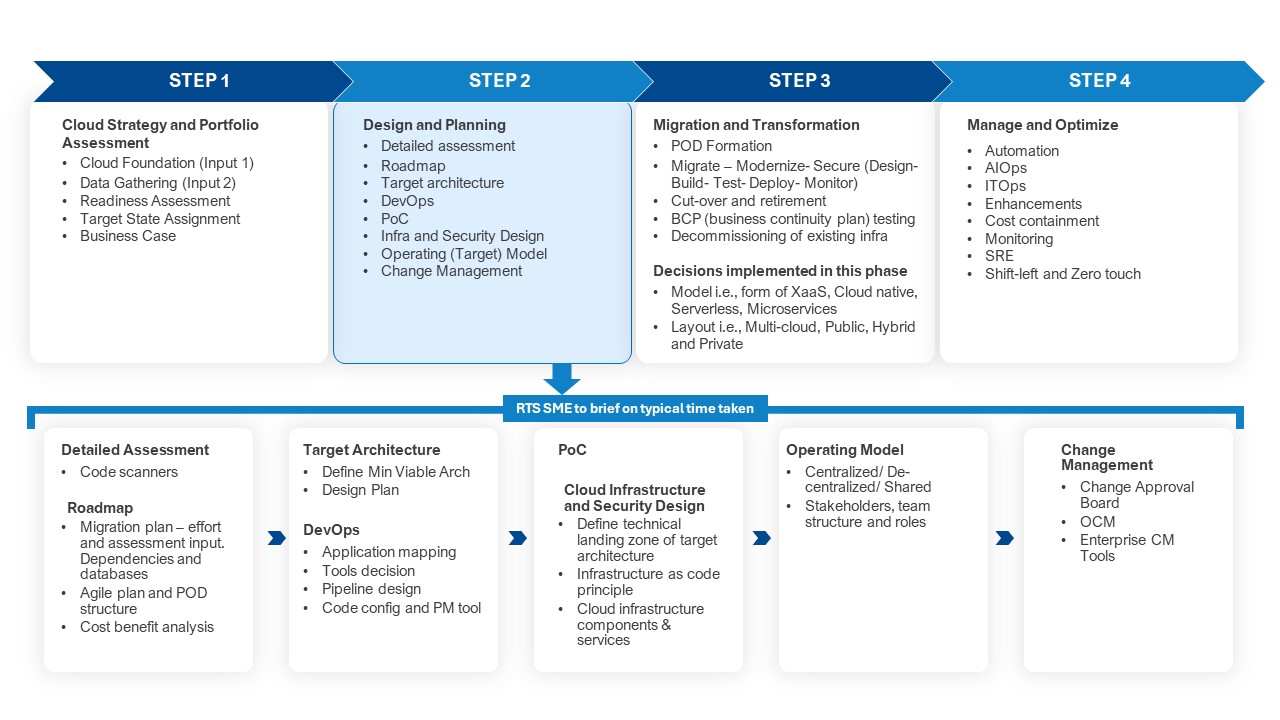Cloud Migration
Migrate to the cloud and unlock endless possibilities for innovation, agility, and scalability.

The cloud is transforming the way businesses operate. By migrating your on-premises applications and data to the cloud, you can gain access to a wide range of benefits, including:
- Reduced costs: The cloud can help you save money on IT infrastructure and maintenance costs
- Increased agility: The cloud makes it easy to scale your IT resources up or down on demand, so you can quickly respond to changing business needs
- Enhanced security: Cloud providers offer a wide range of security features and services to help protect your data and applications
- Improved reliability: Cloud providers offer high-availability and disaster recovery solutions to keep your business running even in the event of an outage
80
+%
of companies have a multi-cloud strategy and a hybrid cloud approach
50
+%
of companies have these two top initiatives
1. Optimizing existing use of cloud (cost savings)
2. Migrating more workloads to cloud
1. Optimizing existing use of cloud (cost savings)
2. Migrating more workloads to cloud
32
%
of cloud spend is wasted
How to start – Avoid Failure with RTS’ expertise
Why shift?
- Understand the trigger and remember it through the transformation
- Is it to, get out of a data center or make change easier or overcome application limitations? The “why” must be the North Star
Speed
- Run fast and regroup and clean up at key points OR do it once, do it slowly and then move on. Decide and understand the implications
- Start with looking for re-platform opportunities with core business applications, if speed is important
DevOps
- Cloud without the DevOps journey becomes limited, but cloud and DevOps journeys in tandem become complicated. How do you find the balance?
- DevOps isn’t about technology, it is about managing incidents and change
- How much automation do we want to put in place, so we’ve got automated CI/CD pipelines?
- Make your devops decisions with all the understood
Security teams
- If you make them an afterthought, they can be justified impediments to the program. Involve them early
Minimum viable cloud
- Define upfront security framework, operations Framework, automation Framework, core account Structure, and networking architecture
Database migrations and licensing
- For databases, the timeline and client licensing agreements makes decisions more often than technology. Understand them upfront and set expectations
Orphan applications
- Far too often have we seen applications with no documentation and the people that know about it have long been out of the organization
- Create the budget for discovery and code scanning tools
Cutover
- Focus on cutover from the beginning till the end, not just before it happens
Hire or train?
- We recommend both. From a, change management perspective, affordability, a retention of tribal application knowledge view and from an infusion of current tech awareness point of view
- Ensure you have a cloud first architect
Cost
- The cost can balloon on the cloud as DC replication isn’t the answer. Figure out what you need and switch those on as required
The 7R Assessment – Identifying the best path for your organization
- Re-host (lift and shift)
- Re-Locate (rewrite and shift)
- Re-factor (re-architect)
- Re – Platform (lift and reshape)
- Re-purchase (cloud-to-cloud migration)
- Retire (decommission legacy frameworks)
- Retain (retain control in local data centers or on-premises)

A Seamless Migration with RTS

$
10
M
RTS saved US government agency $10M over 5 years by eliminating mandatory tech refreshes in security & defense data centers.
30
%
RTS improved system availability for a US government agency by over 30%
25
%
25% reduced costs at client by 25% with cloud support & system.



